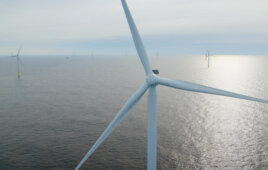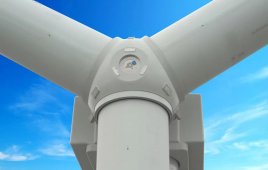GE announced earlier this month that it received a $1.4 billion contract from independent power producer Caithness Energy to supply wind turbines and provide services for an 845-megawatt (MW) wind farm project to be located in Oregon. The wind farm, called Shepherds Flat, has received the majority of the necessary government permits to operate and is ready to be built. When completed it will be larger than any wind farm currently in operation around the globe and will be powered by 338 of GE’s 2.5 MW wind turbines.
“This project underscores our commitment to harness the power of wind to meet present and future energy needs while reducing greenhouse emissions. The Shepherds Flat project will add more renewable energy to the west coast’s energy mix and help the region meet its demand for clean energy,” said Les Gelber, a partner at Caithness Energy.
“GE wind turbines have a strong track record of performance that has been proven in nearly every form of climate worldwide. Their ability to continually advance wind turbine technology will help us to provide our customer, Southern California Edison, with the reliability they expect,” added Gelber.
“The Caithness project highlights our ability to deliver integrated solutions in the clean energy space and it supports our overarching focus to provide first in class technology to our customers,” said Steve Bolze, president and CEO of GE Power & Water.
The Shepherds Flat wind farm is the first in North America to deploy GE’s 2.5xl wind turbine, which has been proven in Europe and Asia.
“The 2.5-MW wind turbine is the latest evolution of GE’s wind turbine technology and provides customers with greater efficiency, reliability and grid connection capabilities. The 2.5-MW builds upon the success of GE’s 1.5-MW wind turbine, the world’s most widely deployed wind turbine with more than 12,000 installed,” said Bolze.
Caithness Energy estimates that the $2 billion project will inject $16 million annually of direct economic benefits into Oregon, and will employ 400 workers during construction and 35 during operation. Construction will be on a large scale not only because of the large number of turbines, but because 85 miles of road and 90 miles of power connection to the grid will be built. Construction is scheduled to begin in 2010 and be completed in 2012.
The 2.5xl wind turbines for the Shepherds Flat wind farm will be assembled at GE’s site in Pensacola, Florida. In addition to supplying the wind turbines, GE will provide ten years of operational and maintenance services to the project. GE Energy Financial Services, which holds a large portfolio in more than 40 wind farms with a total capacity of 6 GW is also investing in the Shepherds Flat project.
In addition to supplying the wind turbines, GE will provide ten years of operational and maintenance services to the project.
“As the nation’s leading utility for renewable energy, we are enthusiastic about the size and quality of this project,” said Marc Ulrich, Southern California Edison Vice President, Renewable and Alternative Power. “Wind power is an essential component to creating a clean, green energy future for California and the rest of the nation.”
The project will help California meet both its capacity needs and renewable energy goals. With the capability to generate two billion kilowatt-hours per year of renewable energy, the wind farm will represent one of the largest projects in Southern California Edison’s renewable portfolio. The project will provide enough clean energy to power approximately 235,000 average California households – according to US Environmental Protection Agency methodology – and will avoid more than 1.5 million tons a year in greenhouse gas emissions, compared to equivalent fossil fuel generation.
Filed Under: Projects





Al, it’s hard to say exactly what the cost of operating a wind turbine is. Many factors come in to play such as wind speed, wind consistency, and demand for the electricity at the time it is produced. Unlike a gas or coal fired turbine which has consistent input/output variables, wind is not consistent. However, if a turbine were to produce at 12-15 cents per kWh over a 20 year life, that would be considered cheap. However, if a plant operator can keep the turbines running strong after the 20 year amortization mark, all the subsequent power (by accounting rules) is free. So to sum up my thoughts, it really depends on too many variables to give such a generic answer, but I wouldn’t expect better than 12 cents/kWh.
Powered by 338 of GE’s 2.5 MW wind turbines. What is the cost $/kW Hr for a 2.5MW wind turbine? Reciprocating engines operating on gas is around a .01 $/kW Hr.
That is truly great news!
I really appreciate having articles published that show some progress in bringing more wind power projects and positions into the USA.